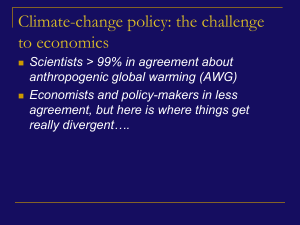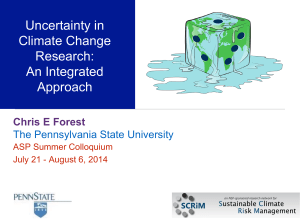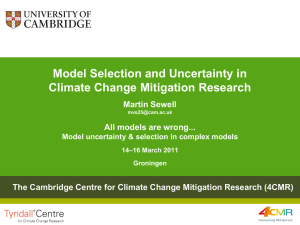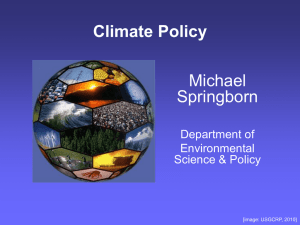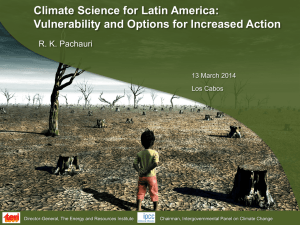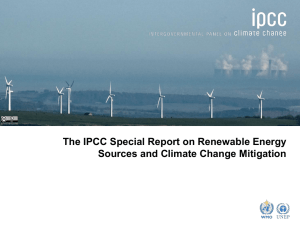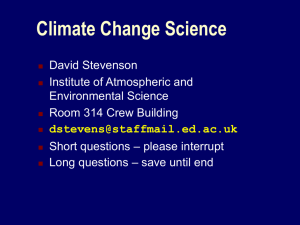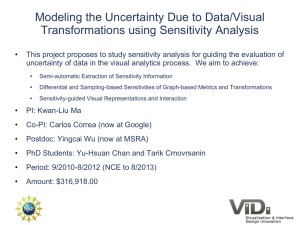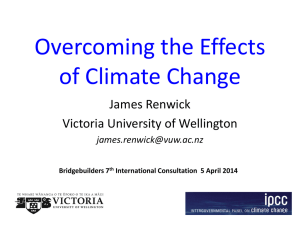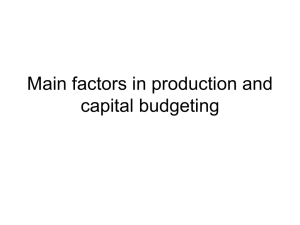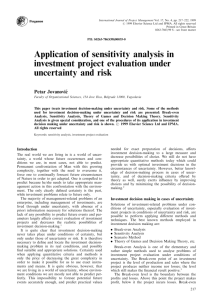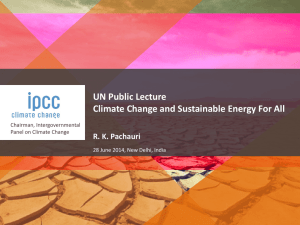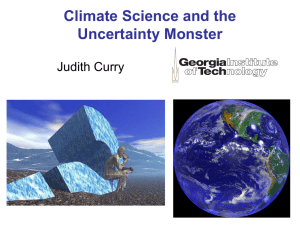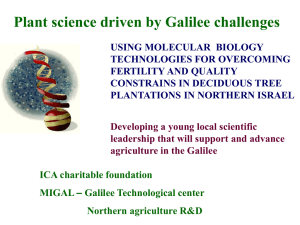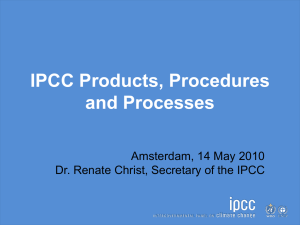20100527101511001
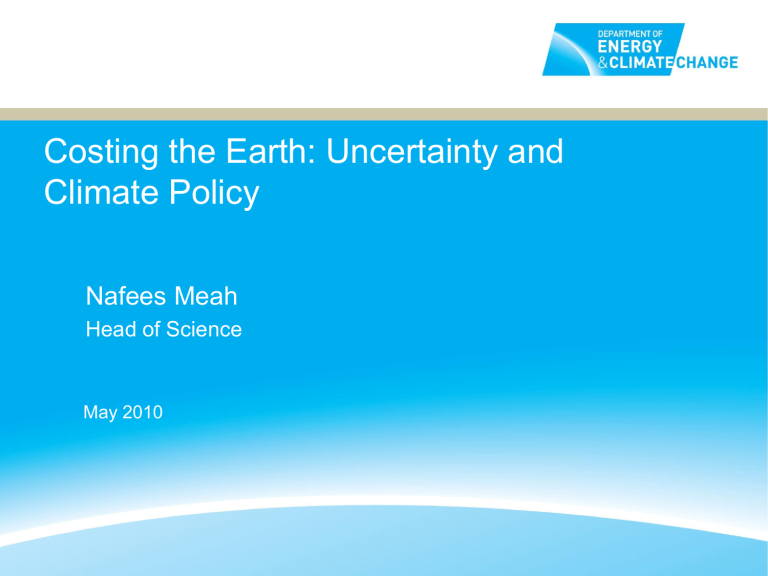
Costing the Earth: Uncertainty and
Climate Policy
Nafees Meah
Head of Science
May 2010
Climate Change As ‘Hard’ Problem
In Public Policy
As a public policy issue, climate change is a classic example of a ‘wicked’ problem
Notwithstanding the compelling scientific evidence, it is still contested
It is the case that there is and will always be irreducible scientific uncertainty – we cannot do a controlled experiment on the planet
Even if there is consensus on the science, that does not tell us what we ought to do: what are the trade-offs that the decision-makers need to consider?
Outline
Summary of the science of climate change
The 2 degree target – AVOID Programme
Key questions in the economics of climate change
Economic modelling and cost-benefit analysis
Stern Review and its critics
Bottom up technical/economic models
The task facing the decision maker
Carbon Dioxide Concentrations In The
Atmosphere Since The Beginning Of The
Industrial Revolution
MacKay (2009)
Evidence that CO
2 is Man Made
Last decade has been the warmest since records began
Observed Global Temperature
Changes Not Explained by Natural
Factors Alone
Year to year range of modelled global temperatures
Climate models show the observed warming is only explained by including human effects through GHG emissions
Excluding human influence
By 2100 Global Temperature is likely to be1.8 to 4 o
C Above 1990
Level
The scale of warming depends on emissions:
Low scenario 1.1 – 2.9
o
C
Best estimate 1.8 – 4.0
o
C
High scenario 2.4
– 6.4
o
C
IPCC (2007)
Projected temperatures – land and polar regions warm more than oceans
IPCC (2007)
IPCC Fourth Assessment
Report 2007
“Warming of the climate system is unequivocal , as is now evident from observations of increases in global average air and ocean temperatures, widespread melting of snow and ice and rising global average sea level”
–
p2, IPCC Synthesis
Report
Temperature, Sea Level and Snow
Cover
• The Earth’s surface has warmed by
0.75
C since 1900
• Sea levels have risen by 20cm since
1900
• Now: glaciers, snow cover and sea ice are all declining
• Now: more heatwaves, droughts, extreme rain events and more intense cyclones
IPCC (2007)
Arctic Ocean September Ice Extent
0 °C
Food
Impacts of climate change
Global temperature change (relative to pre-industrial)
1 °C 2 °C 3 °C 4 °C 5 °C
Falling crop yields in many areas, particularly developing regions
Possible rising yields in some high latitude regions
Falling yields in many developed regions
Water
Small mountain glaciers disappear – water supplies threatened in several areas
Significant decreases in water availability in many areas, including
Mediterranean and Southern Africa
Ecosystems
Sea level rise threatens major cities
Extensive Damage to Coral Reefs
Rising number of species face extinction
Extreme
Weather Rising intensity of storms, forest fires, droughts, flooding and heat waves
Events
Risk of Abrupt and
Major Irreversible
Changes
Increasing risk of dangerous feedbacks and abrupt, large-scale shifts in the climate system
Cascade of uncertainty
Emission scenario
Atmospheric concentrations
Climate sensitivity
Climate change
Range of
Impacts
Impacts may not increase linearly with warming
Lenton (2007)
Climate Sensitivity: Temperature
Response of doubling [CO
2]
Q = F-
λ∆T
Where Q = energy balance,
F = forcing and λ = feedback parameter
At eqm Q=0
F = λ∆T
For the special case of doubling CO
2
F’ = λS
Where S = Climate sensitivity
AR4 concluded that best estimate of climate sensitivity was 3 0 C with range of 2-4.5
0 C (ca. 2SD)
IPCC (2007)
Climate feedbacks include
Feedback
Water vapour
Cloud radiation
Ocean-circulation
Ice-albedo
This is the most important.
Water vapour is a powerful greenhouse gas.
Complex impact. Several processes involved. Sensitive to structure of clouds
Plays large part in determining earth’s climate. Large heat capacity and moves heat around.
Ice and snow are a powerful reflector of solar radiation
Climate feedbacks affect the sensitivity of the climate.
Why a ‘fat’ tail?
AVOID Programme and the 2 degree target
2 degree target agreed at Copenhagen Accord balances risks against technical and social feasibility in an informal way
AVOID examined variations in:
1.
The year of peak emissions (2014 to
2030)
2.
The emission rates leading up to the peak (BAU)
3.
The emissions reduction rate following peak emissions (1 to 5% per year)
4.
The net long-term level of emissions
(zero to high levels)
Business as usual
Policy scenario
AVOID Programme: 2 degree trajectories
AVOID uses a ‘tuned’ climate model (MAGICC)
Global average temperature determined by cumulative emissions of GHGs (2.63TtCO2e 2000-2500)
Approximates to the area under the curve
Take home message is that to stabilise temperature at 2 degrees is going to be a huge challenge - we need to peak soon and STRONG decline thereafter
GHG emission trajectories consistent with 2˚C increase in global average temperature at 2100 at a 50% probability level
Action on Climate Change
Key questions
1.
How much will it cost to ‘stabilise’ the climate and avoid dangerous climate change?
2. Will the cost of avoiding dangerous climate change compete with other priorities such as development?
What action do we take in the light of the scientific evidence for climate change?
So if we applied the appropriate discount rate , then we might say that action would be justified on cost-benefit grounds if:
NPV = Present Value (benefits) – Present Value (costs) > 0
Or for a range of alternative policy actions, choose the one with highest NPV
Uncertainties in economic modelling of climate change
This is a formidable challenge because:
We do not and cannot know the precise benefits of policy action given the underlying uncertainty in the science
We do not and cannot know what the future cost of the policy will be given the long time horizons
Costs and benefits functions are likely to be highly non-linear
and we don’t know what they are
If standard economic models are based on marginal changes, how do we account for irreversibilities?
Given the very long time horizons, what is the appropriate discount rate to use?
Economic models for climate policy
Number of different kinds of economic models
Much of the debate is about Integrated
Assessment Models (IAMS) which seek to integrate science and the economic theory to optimise climate policy
These are utility maximising models which seek to maximize, W, the social welfare, where
W = ∫ exp(-ρt)U[c(t)]dt
Where ρ is the rate of pure time preference, c(t) is the consumption at time t, and
U is the utility function specifying how much utility is derived from a particular level of consumption
Global economic activity
Outputs from Integrated Assessment
Models
Reference case without impacts
Cost of policy
Reference case with impacts
Benefits of policy
Time
Stern Review
Uses PAGE 2002 Integrated Assessment Model
Takes account of risk and uncertainty through Monte Carlo simulations on the climate sensitivity parameter, assumptions on risk aversion and equity
Key finding
Cost of trajectory consistent with 550ppm CO2e stabilisation averages 1% of global GDP per year (range
-1% to 3.5%)
Avoided damages would be 11% of GDP (range 2-27%) for Baseline climate and 14% (range 3-32%) for High climate
This contrasts with other IAMs which suggest a higher level of cost and lower level of damage – DICE, MERGE, FUND
Other models propose ‘policy ramp’ and modest rates of GHG reduction
The critics
Main criticism in the literature has been over the choice discount rate used by the Stern Review
– should instead have used a market rate (i.e. 3
– 7%)
In the Ramsay formula, the social discount rate is given by :
Social discount rate =
+ (
x consumption/cap growth rate)
Reflects pure rate of time preference
(which Stern suggest should be
0) and risk of human extinction
(which Stern select as 0.1).
Elasticity of marginal utility of consumption
(Stern suggest this is
1, which assumes society is moderately adverse to income inequality).
Growth in per capita consumption varies over time and according to extent of climate change damages. For baseline climate scenario with market impacts only, the
5-95% range of timeaveraged growth is 1.08%
- 1.14%.
Therefore in Stern, discount rate = 0.1 + (1*(1.08 to 1.14%)) = 1.18 to 1.24%
Discount rate have an important effect on the present value of climate change impacts
Value of £100 over time using different discount rates
£
100
90
80
70
60
90.479
60.577
81.865
0.1%
1.0%
5.0%
0.5%
2.0%
10.0%
50
40
30
36.603
36.696
20
13.262
10
0
0.623
0.003
0 10 20 30 40 50 60 70 80 90
100 110 120 130 140 150 160 170 180 190 200
13.533
1.759
Years
On Extreme Uncertainty of Extreme
Climate Change – Martin Weitzman
Implication of the fat tail of climate sensitivity
Translating the pdf of climate sensitivity into confidence levels for temperature change as a function of GHG concentrations gives:
So at 550 ppm there is a 10% of T >4.8 ˚C. This is disturbing and can’t be ignored in formal economic modelling.
Damage function
Thought experiment on the damage function, which often takes the quadratic form in IAMs of:
C*(T) = 1/ 1+aT 2
Where C*(T) is defined as the ‘welfare equivalent’ consumption as a fraction of what the consumption would be at T=0, and a=0.003
However, it is impossible to know a priori what the functional form should be for high temperatures
What if we used quartic or exponential form then the estimated damages would be very different
For a quartic exponential function, C*(T) = exp(-bT 4 ), then at 10
˚ C C*(T) is 0.08% i.e. a catastrophic loss of ‘welfare equivalent’ consumption
Technical feasibility models -
McKinsey Marginal Abatement Cost
Curve – Bottom up estimates
Generally optimistic – it can be done and at comparatively small cost !
Choices facing the decision makers
Is formalised cost-benefit analysis appropriate for climate change policy?
If the answer is ‘no’ what other approach should we adopt?
Given that a 2 ˚C has been adopted, should economic analysis focus on seeking the cost effective pathway
Is a risk based approach formalising the ‘precautionary principle’ the appropriate way forward?
Do we need more scientific knowledge on threshold temperatures for major discontinuities or catastrophe’s?
What else is there any other approach that we should consider?
Thank you for your attention
Finally....
